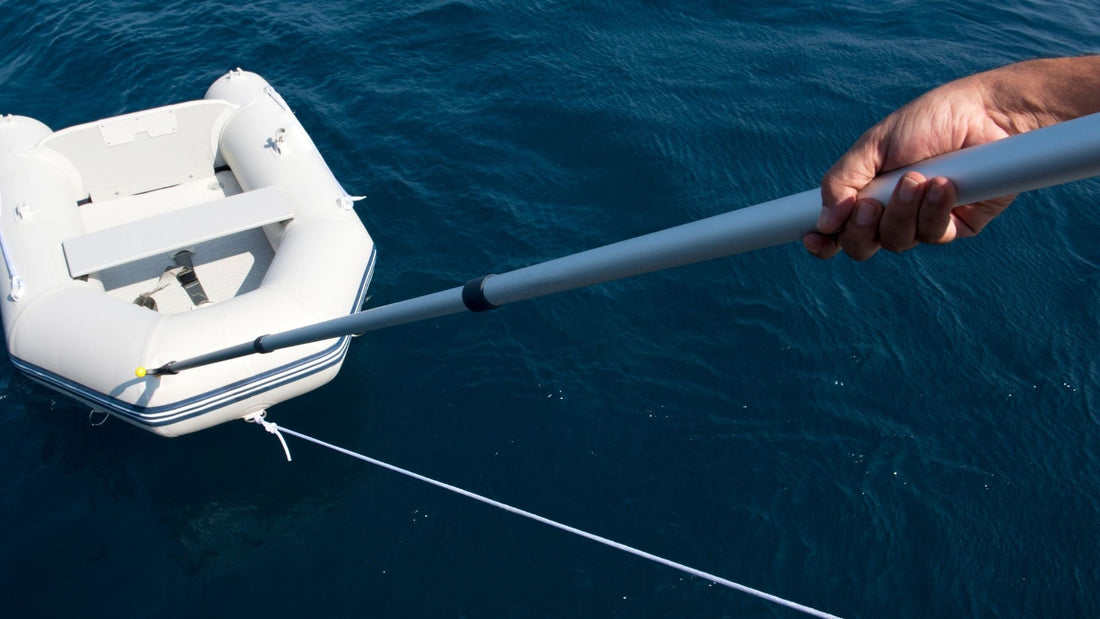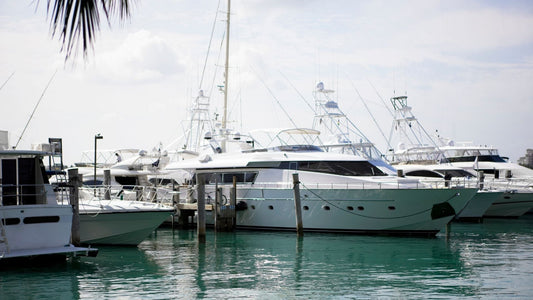
What is a Boat Hook Used For?
Nicholas HeislerShare
Whether you're docking a pontoon, retrieving a line from the water, or just trying to keep your boat from bumping into a piling, a boat hook is one of those simple tools that quickly proves its value. It might not be as exciting as a fishfinder or as technical as a VHF radio, but ask any seasoned boater and they'll tell you: don't leave shore without one.
In this guide, we'll explore the many practical uses of a boat hook, the different types available, and why a floating and telescoping shorty boat hook is an especially handy choice for boaters of all types-from paddleboarders to cruisers. Let's dive in.
What is a Boat Hook?
At its core, a boat hook is a pole with a hook on the end, often made of lightweight, corrosion-resistant materials such as aluminum or fiberglass. The hook is typically shaped to allow grabbing, pushing, pulling, and snagging various objects-ropes, cleats, rings, buoys, and even people (in rescue situations).
Most boat hooks feature a rubber or plastic handle grip for comfort and non-slip handling, with the hook end often made from molded plastic or stainless steel for strength and durability. Some even have threaded tips for attaching accessories like scrub brushes or gaffs, making them even more versatile.
Length-wise, they range from compact 2-foot "shorty" versions up to 12-foot extendable poles that collapse down for storage.
Primary Uses of a Boat Hook
You'll be amazed at just how many tasks a boat hook can help you with. It's one of the most versatile tools on board, especially when you're boating solo or with minimal crew.
1. Docking and Undocking Assistance
Approaching a dock can be stressful, especially in wind or current. A boat hook helps you reach out to grab a cleat, piling, or dock line without having to lean dangerously over the edge of the boat. You can also use it to push off gently from the dock when leaving.
2. Retrieving Lines and Objects
Dropped your mooring line in the water? Need to grab a fender that floated out of reach? A boat hook makes it easy to retrieve gear, ropes, or anything else that slipped away-without diving in.
3. Pushing Off From Other Boats or Obstacles
In tight quarters like a marina or during a raft-up, a boat hook gives you the reach to gently fend off other boats, pilings, or seawalls. This helps prevent scrapes and protects your gel coat from damage.
4. Holding Position Temporarily
Need to maintain your position near a dock or mooring while someone prepares to tie up? You can use your boat hook to "hold" the boat steady by catching a cleat or piling, buying valuable seconds while securing your lines.
5. Navigating Shallow or Weedy Waters
Some boaters use the hook end to test water depth near shore, or to clear weeds or debris off of their outboard motor or anchor line-especially in areas with heavy vegetation.
Types of Boat Hooks and How to Choose the Right One
There's no one-size-fits-all boat hook. The best one for you depends on your boat size, typical activities, and storage constraints.
Fixed-Length Boat Hooks
These are simple, sturdy, and ready to use-no need to extend or collapse. They're great for larger boats with ample storage space but can be bulky on smaller craft.
Telescoping Boat Hooks
These can extend up to 8 or even 12 feet, then collapse to a fraction of that size. Telescoping boat hooks are ideal for boaters who need reach but want to save space. Look for ones with secure twist-lock mechanisms or snap buttons to avoid accidental collapse during use.
Floating Boat Hooks
Some boat hooks are built to float if dropped overboard, with foam grips or sealed shafts. These are especially useful for small boaters and solo operators who might not be able to retrieve a sunken hook.
Shorty Boat Hooks
These compact hooks are designed for dinghies, kayaks, paddleboards, and personal watercraft. They're often under 3 feet in length, making them easy to stow in tight spots.
Real-World Examples of How Boat Hooks Are Used
- Launching From a Rocky Shore: A kayaker uses the shorty hook to push off without scratching the hull.
- Solo Boater Grabs a Mooring Ball: Reaching forward with the extended hook, they pull the line toward them.
- SUP Paddler Retrieves a Water Bottle: The hook saves them from jumping in-or chasing it downwind.
Tips for Using Your Boat Hook Safely and Effectively
- Extend Carefully: Make sure the telescoping mechanism is fully locked before use.
- Avoid Leaning Too Far: Don't reach too far beyond your center of gravity-especially on paddleboards or small boats.
- Secure After Use: Boat hooks can easily roll or slide around the deck. Use a clip or designated holder.
- Rinse After Saltwater Use: Even corrosion-resistant metals last longer with regular rinsing.
Where to Buy a High-Quality Boat Hook
You can find reliable shorty boat hooks from a variety of trusted marine retailers:

- Captain's Preferred Products - This budget-friendly boat hook attachment can be added to a telescoping pole for a shorty hook and telescoping long handle combo.
- West Marine - Carries multiple models, both premium and budget-friendly.
- Local Marine Supply Stores - Great for hands-on inspection before buying.
An Extra Hand on the Boat
Boat hooks may be simple tools, but they're incredibly versatile and absolutely essential for safe, confident boating. Whether you're docking solo, grabbing a mooring line, or just need a bit of extra reach, a boat hook can make all the difference.
Don't wait until you're in a tight spot. Add a quality boat hook to your onboard gear today-you'll thank yourself later.
For boat hooks, dock lines, and other boat docking supplies, look to Captains Preferred Products for the best value gear for the boat.




